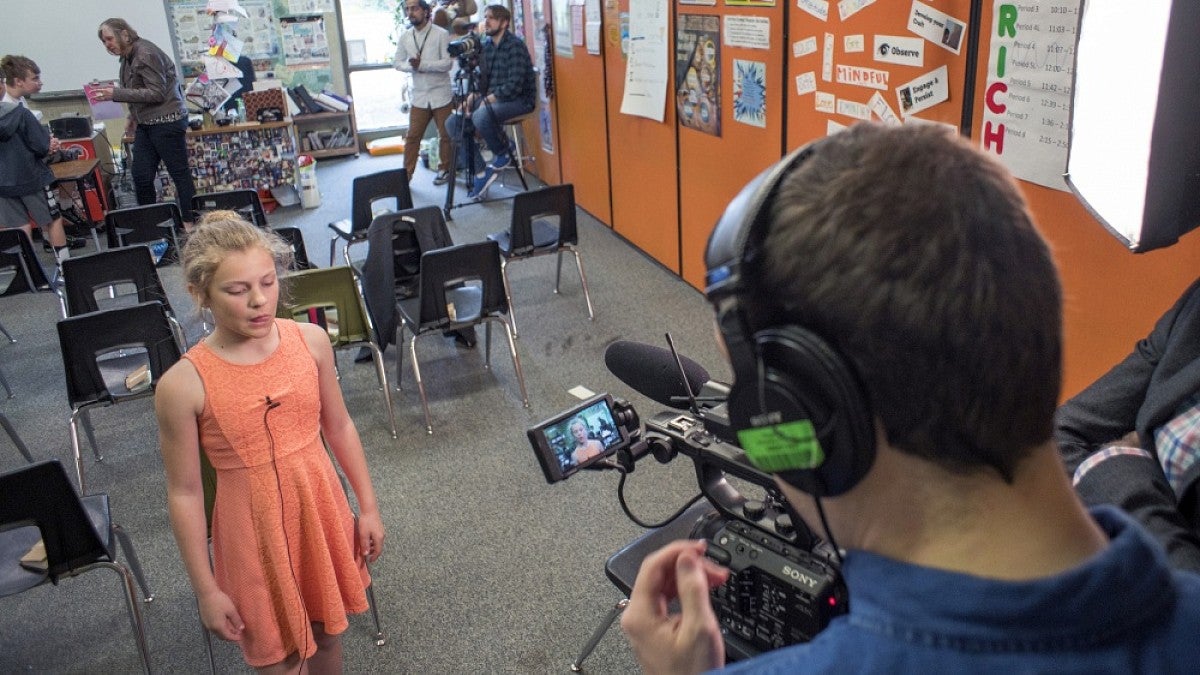Both journalism and education are part of Ed Madison’s DNA.
The son of a reporter and a teacher, Madison spent 27 years as a broadcast journalist and producer before joining the UO School of Journalism and Communication as an assistant professor. Now he's combining the two fields in a project that could fundamentally change the classroom experience for grade-school students across the nation.
The Journalistic Learning Initiative, a collaboration between the journalism school and the College of Education, is the culmination of eight years of research into and development of journalism-based teaching strategies — such as researching, interviewing and writing — to enhance learning outcomes for secondary language arts and social studies.
The initiative also focuses on developing a skill Madison calls “informed thinking.”
“An informed thinker is someone who has researched a topic and has been very thoughtful to make sure that what they're presenting is credible, valid and well researched,” he said. “An informed thinker doesn't just consume information but … also creates content.”
In addition to a $3,000 grant from the school’s Petrone Research Fund, the Journalistic Learning Initiative is supported by education innovators Esther Wojcicki and Tara Guber. Wojcicki leads the award-winning scholastic journalism program at Palo Alto High School, which recently opened its own Media Arts Center. Guber, the founder of the internationally established health and wellness program Yoga Ed, provided seed funding.
Wojcicki and Guber are key collaborators in facilitating the program’s growth.
“I believe that in the journalistic learning process, Esther and Ed have discovered the contemporary DNA of effective learning in the digital age,” Guber said. “Journalistic learning is a game changer. It fundamentally shifts the focus and purpose of learning from the teacher to the student, and it builds and strengthens fundamental life skills necessary for success and fulfillment. It is simply the most conscious, values-based, holistic and effective education program I have seen to date.”
Based on the results of the project’s two pilots, at Palo Alto High School in California and Oaklea Middle School in Junction City, the initiative’s student-centered approach not only improves students’ skills, it also helps them develop stronger voices and become more invested in their education.
Madison, who graduated from the School of Journalism and Communication’s media studies doctoral program in 2012, became aware of Palo Alto High’s journalism program in 2010 while conducting research for his dissertation. He was struck by the fact that roughly 500 of the school’s 1,800 students participated in some form of media arts.
“There is an expectation that these kids are going to live in privilege and are going to be exposed to things that other kids aren't,” Madison said. “So a good part of my work has been studying what they do there and really looking at what can be applied in communities where there's not that level of affluence.”
Students enrolled in the initiative’s two pilot projects research and report on topics of their choosing, from cutting-edge robotics to social justice issues. They identify experts in their chosen field or “beat” and lead virtual press conferences via Skype. Based on their notes, they write and publish profiles and feature stories.
Along the way, both the students and their teachers are mentored by certified Journalistic Learning Initiative educators, most of whom are recent journalism school graduates who get special training in teaching to supplement the journalistic skills they learned in college.
“We offer them a gap year where we place them alongside a middle school or high school English or social studies teacher,” Madison said. “What that does is infuse a fresh perspective and bring someone in who has media skills. We are not only supplementing and supporting what's already going on in that classroom, but providing a journalistic perspective to their learning.”
The curriculum at Oaklea is broken up into 10-week trimesters that give equal time to research, interviewing and publishing. Now in their final trimester, the students are pursuing stories about issues that impact their community. The class is almost ready to present its finished work.
Madison recalls one lesson where sixth-grade students at Oaklea Middle School learned about cultural sensitivity and practiced asking respectful questions. They selected the question they thought was most culturally sensitive and justified their decisions in an open classroom discussion. They could also write in their own question.
One student, who identified as coming from a low-income family, argued that the question, “What’s it like to be poor?” was more culturally sensitive than one that asked, “Can you tell me more about your background?”
“He said, ‘Well, I think that it's more appropriate to just be upfront and be honest,’” Madison recalled. That kind of nuanced discussion, he says, is at the crux of what the Journalistic Learning Initiative is trying to create in the classroom.
As the initiative picks up steam and new partners, Madison intends to open up the program to other K-12 campuses along the West Coast and, after that, across the country.
“We have a partnership with an organization in Los Angeles called Young Eisner Scholars,” he said. “We will be starting a JLI school or providing the JLI curriculum to a school in Los Angeles starting in September.”
Ultimately, the program’s goal is to make a real contribution to the movement to rethink the K-12 classroom.
“We're developing this curriculum as we go, so we're learning along with the students,” Madison said. “When you talk to these kids, you know there's something going on there that they're not experiencing in other classes, in other parts of the day.”
—By Aaron Weintraub, School of Journalism and Communication


